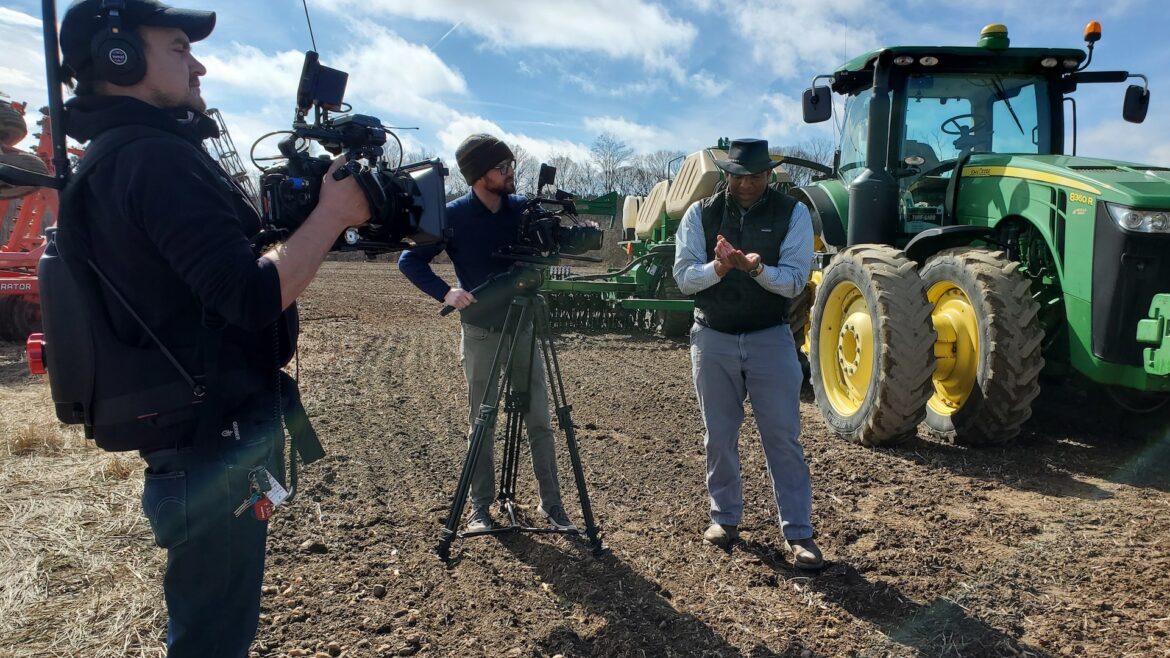New VPM show highlights rural Virginians improving their communities

Lysandra Peterson
A "Life in the Heart Land" production crew films P.J. Haynie. a farmer and owner of Haynie Farms in Reedville, Va.
A new show from Virginia’s VPM explores how residents of the state’s rural areas are working together to improve their communities, many of which lack adequate food, housing and internet access.
The inspiration for Life in the Heart Land, created in partnership with Deep Structure Productions, was to celebrate voices from rural communities, according to Lysandra Petersson, Deep Structure’s director of production and operations. Deep Structure has previously partnered on documentaries with The Washington Post and has produced commercial pieces for Virginia businesses and politicians.
“We need more uplifting, positive stories,” Petersson said. “We need to give people hope, because there’s so much just negativity.”
She describes the show as a collection of “shallow deep dives,” with each 26-minute episode going into depth on a specific topic.
Petersson, who grew up on farms in Virginia, adopted the idea for the show from a friend who had worked on documentaries about farm life. Petersson was originally meant to be production coordinator, but the project ended up being turned over to Deep Structure in January 2021 after the coronavirus pandemic caused staffing changes.
Funded by VPM, the debut season of eight half-hour episodes examines issues such as farming, broadband access, recycling and justice reform. Each episode features community members working to address the issue, along with local experts on the topic.
The first episode, which aired March 9, focused on food access. It featured two sisters from Staunton, Va., who are working to transform an unused lot into a community garden; a county administrator who aims to establish a pantry in the middle of a food desert; and the executive director of Virginia Tech’s Center for Food Systems and Community Transformation.
“We felt like it was very important to get out and meet people where they are and [have them] tell us the stories and the experiences they have,” said VPM EP Mason Mills.
A ‘community-driven effort’
Mills noted that the show has brought issues that have been overlooked by lawmakers to the forefront. Local leaders have contacted VPM to praise the show for its focus on rural life.
A Habitat for Humanity chapter in Powhatan, Va., shared a Heart Land episode about housing with its staffers and 100 people in its network. It will also include the episode in a June workshop about rural housing.
“Their response was ‘Your story nailed everything we’ve been trying to tell people about the issues with housing,’” Mills said.
“We don’t make these stories with the intention of these organizations and these people that tell us that they use it or want it. We make it to tell the story,” he said. “But then they come to us saying ‘Man, this is the perfect story for us to share what’s important to us.’”
The eighth episode of the show, which focused on broadband access, scored the Heart Land production team an invitation to a conference with internet providers and local leaders, who praised the show’s work on depicting rural struggles with internet access.
“No one else is going to come to this area and save us,” said Mike Keyser, former CEO of the BARC Electric Cooperative, in the episode. “We’re the only ones that can do this.”
Throughout May, VPM is hosting screenings of Life in the Heart Land in Staunton. A Thursday screening and discussion in Harrisonburg drew about 100 attendees.
Mills said community members have also praised the show and say they feel like they’re finally seeing their lives on screen.
“It’s a really community-driven effort,” Mills said. “It’s not VPM coming in and telling your story. … We want you to be highly involved in that process. We want you, and the people that live in that community, to be involved, to not to be passive.”
VPM is planning to produce a second season of the show, and Mills said he intends to involve even more community members. He also hopes that other stations will broadcast the program.
Corrections: An earlier version of this article incorrectly said that Petersson was originally meant to be a producer on Life in the Heart Land. She was meant to be production coordinator. The article also incorrectly said that about 150 people attended a May 4 screening of the show in Staunton, Va. About 100 people attended.






